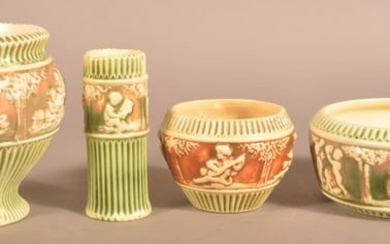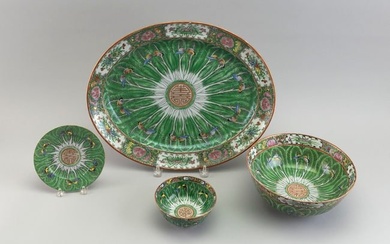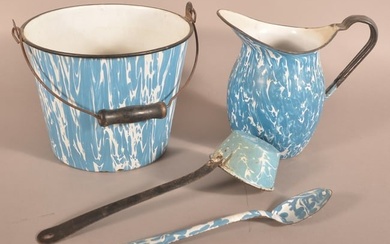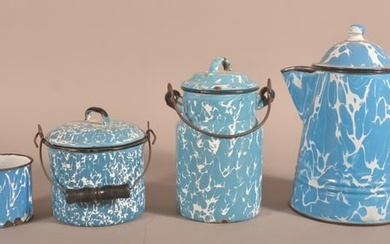Funerary ensemble of 17 Pieces in Green and Enamel over
Funerary ensemble of 17 Pieces in Green and Enamel over polychrome terracotta.Ming dynasty, XVth-XVIth century.17 pieces of different sizes and typologies in Green and Enamel over polychrome terracotta. The four “figurines”: h. 380 mm. Some damages restored, and some defect.
Further Details
Extraordinary and Preserved Funeral Ensamble of Terracotta Glazed Figures in green and caramel colors depicting a votive procession with four statues “figurines”, a chest with offerings for the afterlife, a duck, some daily life objects and a large altar. A rare Ming dynasty terracotta funerary set from 15th-16th century. This set was made with terracotta during the Ming Dynasty and displays a variety of elements of food and drink.Called Mingqi, these kinds of terracotta models were traditionally placed in the Chinese burials for the wealthy deceased, in order to assist the them in the afterlife, a practice that dates back to the Neolithic Period.Mingqi, sometimes referred to as "spirit objects", are Chinese burial goods. They included daily utensils, musical instruments, weapons, armour, and intimate objects such as the deceased's cap and bamboo mat. Mingqi also could include figurines of soldiers, servants, musicians, polo riders, houses, and horses. Mingqi served to provide the deceased with necessities and comforts in the afterlife. The deceased person's corporeal spirit was said to remain in the realm of the tomb while the ethereal spirit ascended to heaven. To appease the deceased's corporeal spirit mingqi that were relevant and liked by the deceased were placed in his tomb. Upon placing mingqi in the tomb, humans, according to the Confucian ideal, were harmonizing the cosmos by striking a balance for the comfort of the deceased who is also comforted in heaven.For inquiries, detailed condition report and additional images please mail to info@badoemart.it.
Estimate
Time, Location
Auction House
Funerary ensemble of 17 Pieces in Green and Enamel over polychrome terracotta.Ming dynasty, XVth-XVIth century.17 pieces of different sizes and typologies in Green and Enamel over polychrome terracotta. The four “figurines”: h. 380 mm. Some damages restored, and some defect.
Further Details
Extraordinary and Preserved Funeral Ensamble of Terracotta Glazed Figures in green and caramel colors depicting a votive procession with four statues “figurines”, a chest with offerings for the afterlife, a duck, some daily life objects and a large altar. A rare Ming dynasty terracotta funerary set from 15th-16th century. This set was made with terracotta during the Ming Dynasty and displays a variety of elements of food and drink.Called Mingqi, these kinds of terracotta models were traditionally placed in the Chinese burials for the wealthy deceased, in order to assist the them in the afterlife, a practice that dates back to the Neolithic Period.Mingqi, sometimes referred to as "spirit objects", are Chinese burial goods. They included daily utensils, musical instruments, weapons, armour, and intimate objects such as the deceased's cap and bamboo mat. Mingqi also could include figurines of soldiers, servants, musicians, polo riders, houses, and horses. Mingqi served to provide the deceased with necessities and comforts in the afterlife. The deceased person's corporeal spirit was said to remain in the realm of the tomb while the ethereal spirit ascended to heaven. To appease the deceased's corporeal spirit mingqi that were relevant and liked by the deceased were placed in his tomb. Upon placing mingqi in the tomb, humans, according to the Confucian ideal, were harmonizing the cosmos by striking a balance for the comfort of the deceased who is also comforted in heaven.For inquiries, detailed condition report and additional images please mail to info@badoemart.it.







